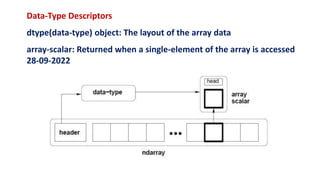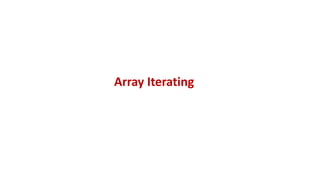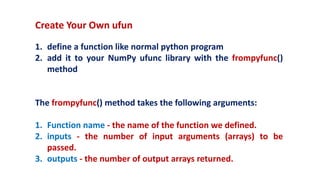NumPy provides two fundamental objects for multi-dimensional arrays: the N-dimensional array object (ndarray) and the universal function object (ufunc). An ndarray is a homogeneous collection of items indexed using N integers. The shape and data type define an ndarray. NumPy arrays have a dtype attribute that returns the data type layout. Arrays can be created using the array() function and have various dimensions like 0D, 1D, 2D and 3D.




![# DataType Output: str
x = "Hello World"
# DataType Output: int
x = 50
# DataType Output: float
x = 60.5
# DataType Output: complex
x = 3j
# DataType Output: list
x = ["geeks", "for", "geeks"]
# DataType Output: tuple
x = ("geeks", "for", "geeks")
# DataType Output: bytearray
x = bytearray(4)
# DataType Output: memoryview
x = memoryview(bytes(6))
# DataType Output: NoneType
x = None
# DataType Output: range
x = range(10)
# DataType Output: dict
x = {"name": "Suraj", "age": 24}
# DataType Output: set
x = {"geeks", "for", "geeks"}
# DataType Output: frozenset
x = frozenset({"geeks", "for", "geeks"})
# DataType Output: bool
x = True
# DataType Output: bytes
x = b"Geeks"](https://image.slidesharecdn.com/numpy-2-230621150236-a67a1e87/85/NUMPY-2-pptx-5-320.jpg)
![Create a NumPy ndarray Object
using the array() function
import numpy as np
arr = np.array([1, 2, 3, 4, 5])
print(arr)
print(type(arr))](https://image.slidesharecdn.com/numpy-2-230621150236-a67a1e87/85/NUMPY-2-pptx-6-320.jpg)


![Dimensions in Arrays
1-D Arrays
An array that has 1-D arrays as its elements is called uni-
dimensional or 1-D array.
Example: Create a 0-D array with value 1,2,3,4,5
import numpy as np
arr = np.array([1,2,3,4,5])
print(arr)](https://image.slidesharecdn.com/numpy-2-230621150236-a67a1e87/85/NUMPY-2-pptx-9-320.jpg)
![Dimensions in Arrays
2-D Arrays
An array that has 1-D arrays as its
elements is called two-dimensional or 2-
D array.
Example: Create a 2-D array with values
1,2,3 and 4,5,6
import numpy as np
arr = np.array([[1,2,3],[4,5,6]])
print(arr)](https://image.slidesharecdn.com/numpy-2-230621150236-a67a1e87/85/NUMPY-2-pptx-10-320.jpg)
![Dimensions in Arrays
3-D Arrays
An array that has 2-D arrays as its elements is
called three-dimensional or 3-D array.
Example: Create a 3-D array with 2 D array values
1,2,3 and 4,5,6
import numpy as np
arr = np.array([[[1,2,3],[4,5,6]], [[1,2,3],[4,5,6]]])
print(arr)](https://image.slidesharecdn.com/numpy-2-230621150236-a67a1e87/85/NUMPY-2-pptx-11-320.jpg)
![Check Number of Dimensions?
NumPy Arrays provides the ndim attribute that returns an integer that tells us how
many dimensions the array have.
import numpy as np
a = np.array(42)
b = np.array([1, 2, 3, 4, 5])
c = np.array([[1, 2, 3], [4, 5, 6]])
d = np.array([[[1, 2, 3], [4, 5, 6]], [[1, 2, 3], [4, 5, 6]]])
print(a.ndim)
print(b.ndim)
print(c.ndim)
print(d.ndim)](https://image.slidesharecdn.com/numpy-2-230621150236-a67a1e87/85/NUMPY-2-pptx-12-320.jpg)
![Higher Dimensional Arrays
An array can have any number of dimensions.
When the array is created, we can define the
number of dimensions by using the ndmin
argument.
import numpy as np
arr = np.array([1, 2, 3, 4], ndmin=5)
print(arr)
print('number of dimensions :', arr.ndim)](https://image.slidesharecdn.com/numpy-2-230621150236-a67a1e87/85/NUMPY-2-pptx-13-320.jpg)





![Checking the Data Type of an Array
The NumPy array object has a property called dtype that
returns the data type of the array:
Example:
import numpy as np
arr = np.array([1, 2, 3, 4])
print(arr.dtype)](https://image.slidesharecdn.com/numpy-2-230621150236-a67a1e87/85/NUMPY-2-pptx-19-320.jpg)
![Creating Arrays With a Defined Data Type
Use array() function to create arrays, this can take an optional
argument: dtype to define the expected data type of the array
elements:
Example:
import numpy as np
arr = np.array([1, 2, 3, 4], dtype='S’)
print(arr)
print(arr.dtype)](https://image.slidesharecdn.com/numpy-2-230621150236-a67a1e87/85/NUMPY-2-pptx-20-320.jpg)
![Converting Data Type on Existing Arrays
The best way to change the data type of an existing array, is to make a
copy of the array with the astype() method.
The astype() function creates a copy of the array, and allows you to
specify the data type as a parameter.
Example:
import numpy as np
arr = np.array([1.1, 2.1, 3.1])
newarr = arr.astype('i’)
print(newarr)
print(newarr.dtype)](https://image.slidesharecdn.com/numpy-2-230621150236-a67a1e87/85/NUMPY-2-pptx-21-320.jpg)

![NumPy Array Copy vs View
Example:
COPY
import numpy as np
arr = np.array([1, 2, 3, 4, 5])
x = arr.copy()
arr[0] = 42
print(arr)
print(x)](https://image.slidesharecdn.com/numpy-2-230621150236-a67a1e87/85/NUMPY-2-pptx-23-320.jpg)
![NumPy Array Copy vs View
Example:
VIEW
import numpy as np
arr = np.array([1, 2, 3, 4, 5])
x = arr.view()
arr[0] = 42
print(arr)
print(x)](https://image.slidesharecdn.com/numpy-2-230621150236-a67a1e87/85/NUMPY-2-pptx-24-320.jpg)
![Array Slicing
• Taking elements from one given index to another given index.
• We pass slice instead of index like this: [start:end].
• We can also define the step, like this: [start:end:step].
• If we don't pass start it’s considered 0
• If we don't pass end it’s considered length of array in that
dimension
• If we don't pass step it’s considered 1](https://image.slidesharecdn.com/numpy-2-230621150236-a67a1e87/85/NUMPY-2-pptx-25-320.jpg)
![Array Slicing
Example:
import numpy as np
arr = np.array([1, 2, 3, 4, 5, 6, 7])
//Slice elements from index 1 to index 5
print(arr[1:5])
Example:
import numpy as np
arr = np.array([1, 2, 3, 4, 5, 6, 7])
//Slice elements from index 4 to the end of the array:
print(arr[4:])](https://image.slidesharecdn.com/numpy-2-230621150236-a67a1e87/85/NUMPY-2-pptx-26-320.jpg)
![Example:
import numpy as np
arr = np.array([1, 2, 3, 4, 5, 6, 7])
//Slice elements from the beginning to index 4 (not included):
print(arr[:4])
Example:
import numpy as np
arr = np.array([1, 2, 3, 4, 5, 6, 7])
print(arr[-3:-1])](https://image.slidesharecdn.com/numpy-2-230621150236-a67a1e87/85/NUMPY-2-pptx-27-320.jpg)
![Example:
import numpy as np
arr = np.array([1, 2, 3, 4, 5, 6, 7])
//Return every other element from index 1 to index 5:
print(arr[1:5:2])
//Return every other element from the entire array:
print(arr[::2])](https://image.slidesharecdn.com/numpy-2-230621150236-a67a1e87/85/NUMPY-2-pptx-28-320.jpg)
![ Taking array and elements from one given index to another given index.
We pass slice instead of index like this:[array index, start:end].
We can also define the step, like this: [array index, start:end:step].
2 D array has two 1D arrays
array index 0 for first 1D array
array index 1 for first 1D array
Slicing 2-D Arrays](https://image.slidesharecdn.com/numpy-2-230621150236-a67a1e87/85/NUMPY-2-pptx-29-320.jpg)
![Slicing 2-D Arrays
Example:
import numpy as np
arr = np.array([[1, 2, 3, 4, 5], [6, 7, 8, 9, 10]])
//From the second element, slice elements from index 1 to index 4 (not included):
print(arr[1,1:4])
Example:
import numpy as np
arr = np.array([[1, 2, 3, 4, 5], [6, 7, 8, 9, 10]])
//From both elements, return index 2:
print(arr[0:2,2])](https://image.slidesharecdn.com/numpy-2-230621150236-a67a1e87/85/NUMPY-2-pptx-30-320.jpg)
![Example:
import numpy as np
arr = np.array([[1, 2, 3, 4, 5], [6, 7, 8, 9, 10]])
//From both elements, slice index 1 to index 4 (not included):
print(arr[0:2,1:4])](https://image.slidesharecdn.com/numpy-2-230621150236-a67a1e87/85/NUMPY-2-pptx-31-320.jpg)
![Array Shape
Shape of an Array
The shape of an array is the number of elements in each dimension.
NumPy arrays have an attribute called shape that returns a tuple with
each index having the number of corresponding elements.
Example:
import numpy as np
arr = np.array([[1, 2, 3, 4], [5, 6, 7, 8]])
print(arr.shape)](https://image.slidesharecdn.com/numpy-2-230621150236-a67a1e87/85/NUMPY-2-pptx-32-320.jpg)

![Reshape From 1-D to 2-D
Example:
Convert the following 1-D array with 12 elements into a 2-D array.
import numpy as np
arr = np.array([1, 2, 3, 4, 5, 6, 7, 8, 9, 10, 11, 12])
newarr = arr.reshape(4, 3)
//The outermost dimension will have 4 arrays, each with 3 elements:
print(newarr)](https://image.slidesharecdn.com/numpy-2-230621150236-a67a1e87/85/NUMPY-2-pptx-34-320.jpg)
![Reshape From 1-D to 3-D
Example:
Convert the following 1-D array with 12 elements into a 3-D array.
import numpy as np
arr = np.array([1, 2, 3, 4, 5, 6, 7, 8, 9, 10, 11, 12])
newarr = arr.reshape(2, 3,2)
//The outermost dimension will have 2 arrays that contain 3 arrays, each with 2 elements:
print(newarr)](https://image.slidesharecdn.com/numpy-2-230621150236-a67a1e87/85/NUMPY-2-pptx-35-320.jpg)

![Unknown Dimension
Example:
import numpy as np
arr = np.array([1, 2, 3, 4, 5, 6, 7, 8])
newarr = arr.reshape(2, 2, -1)
print(newarr)
//Convert 1D array with 8 elements to 3D array with 2x2 elements:](https://image.slidesharecdn.com/numpy-2-230621150236-a67a1e87/85/NUMPY-2-pptx-37-320.jpg)
![Flattening the arrays
Means converting a multidimensional array into a 1D array.
Use reshape(-1) to do this.
Example:
import numpy as np
arr = np.array([[1, 2, 3], [4, 5, 6]])
print(arr) newarr = arr.reshape(-1)
//Convert the array into a 1D array:
print(newarr)](https://image.slidesharecdn.com/numpy-2-230621150236-a67a1e87/85/NUMPY-2-pptx-38-320.jpg)

![Iterating Arrays
• Iterating means going through elements one by one.
• As we deal with multi-dimensional arrays in numpy, we can do this
using basic for loop of python.
• If we iterate on a 1-D array it will go through each element one by one.
Example:
import numpy as np
arr = np.array([1, 2, 3])
for x in arr:
print(x)](https://image.slidesharecdn.com/numpy-2-230621150236-a67a1e87/85/NUMPY-2-pptx-40-320.jpg)
![Iterating 2-D Arrays
In a 2-D array it will go through all the rows.
Example:
import numpy as np
arr = np.array([[1, 2, 3], [4, 5, 6]])
for x in arr:
print(x)
If we iterate on a n-D array it will go through
n-1th dimension one by one.](https://image.slidesharecdn.com/numpy-2-230621150236-a67a1e87/85/NUMPY-2-pptx-41-320.jpg)
![Iterating 2-D Arrays
To return the actual values, the scalars, we have to iterate the
arrays in each dimension.
Example:
import numpy as np
arr = np.array([[1, 2, 3], [4, 5, 6]])
for x in arr:
for y in x:
print(y)](https://image.slidesharecdn.com/numpy-2-230621150236-a67a1e87/85/NUMPY-2-pptx-42-320.jpg)
![Iterating 3-D Arrays
In a 3-D array it will go through all 2D arrays.
Example:
import numpy as np
arr = np.array([[[1, 2, 3], [4, 5, 6]], [[7, 8, 9], [10, 11, 12]]])
for x in arr:
print(x)
[[1 2 3]
[4 5 6]]
[[ 7 8 9]
[10 11 12]]](https://image.slidesharecdn.com/numpy-2-230621150236-a67a1e87/85/NUMPY-2-pptx-43-320.jpg)
![Iterating 3-D Arrays
In a 3-D array it will go through all 2D arrays.
Example:
import numpy as np
arr = np.array([[[1, 2, 3], [4, 5, 6]], [[7, 8, 9], [10, 11, 12]]])
for x in arr:
for y in x:
for z in y:
print(z)
1
2
3
4
5
6
7
8
9
10
11
12](https://image.slidesharecdn.com/numpy-2-230621150236-a67a1e87/85/NUMPY-2-pptx-44-320.jpg)
![Iterating Arrays Using nditer()
Example 1:
import numpy as np
arr = np.array([[[1, 2], [3, 4]], [[5, 6], [7, 8]]])
for x in np.nditer(arr):
print(x)](https://image.slidesharecdn.com/numpy-2-230621150236-a67a1e87/85/NUMPY-2-pptx-45-320.jpg)
![Iterating With Different Step Size
Iterate through every scalar element of the
2D array skipping 1 element:
import numpy as np
arr = np.array([[1, 2, 3, 4], [5, 6, 7, 8]])
for x in np.nditer(arr[:, ::2]):
print(x)](https://image.slidesharecdn.com/numpy-2-230621150236-a67a1e87/85/NUMPY-2-pptx-46-320.jpg)


![Joining NumPy Arrays
Example: Join two arrays
import numpy as np
arr1 = np.array([1, 2, 3])
arr2 = np.array([4, 5, 6])
arr = np.concatenate((arr1, arr2))
print(arr)
[1 2 3 4 5 6]](https://image.slidesharecdn.com/numpy-2-230621150236-a67a1e87/85/NUMPY-2-pptx-49-320.jpg)
![Joining NumPy Arrays
Example: Join two 2-D arrays:
import numpy as np
arr1 = np.array([[1, 2], [3, 4]])
arr2 = np.array([[5, 6], [7, 8]])
arr = np.concatenate((arr1, arr2))
print(arr)](https://image.slidesharecdn.com/numpy-2-230621150236-a67a1e87/85/NUMPY-2-pptx-50-320.jpg)
![Joining NumPy Arrays
Example: Join two 2-D arrays along rows (axis=1):
import numpy as np
arr1 = np.array([[1, 2], [3, 4]])
arr2 = np.array([[5, 6], [7, 8]])
arr = np.concatenate((arr1, arr2), axis=1)
print(arr)](https://image.slidesharecdn.com/numpy-2-230621150236-a67a1e87/85/NUMPY-2-pptx-51-320.jpg)
![Joining NumPy Arrays
Example: Join two 3-D arrays:
import numpy as np
arr1 = np.array([[[1, 2], [3, 4]],[[1, 2], [3, 4]]])
arr2 = np.array([[[5, 6], [7, 8]],[[5, 6], [7, 8]]])
arr = np.concatenate((arr1, arr2),axis=0)
print(arr)](https://image.slidesharecdn.com/numpy-2-230621150236-a67a1e87/85/NUMPY-2-pptx-52-320.jpg)
![Joining NumPy Arrays
Example: Join two 3-D arrays:
import numpy as np
arr1 = np.array([[[1, 2], [3, 4]],[[1, 2], [3, 4]]])
arr2 = np.array([[[5, 6], [7, 8]],[[5, 6], [7, 8]]])
arr = np.concatenate((arr1, arr2),axis=1)
print(arr)](https://image.slidesharecdn.com/numpy-2-230621150236-a67a1e87/85/NUMPY-2-pptx-53-320.jpg)
![Joining NumPy Arrays
Example: Join two 3-D arrays:
import numpy as np
arr1 = np.array([[[1, 2], [3, 4]],[[1, 2], [3, 4]]])
arr2 = np.array([[[5, 6], [7, 8]],[[5, 6], [7, 8]]])
arr = np.concatenate((arr1, arr2),axis=2)
print(arr)](https://image.slidesharecdn.com/numpy-2-230621150236-a67a1e87/85/NUMPY-2-pptx-54-320.jpg)

![Joining Arrays Using Stack Functions
Stack Two 1D arrays:
import numpy as np
arr1 = np.array([1, 2, 3])
arr2 = np.array([4, 5, 6])
arr = np.stack((arr1, arr2), axis=1)
print(arr)](https://image.slidesharecdn.com/numpy-2-230621150236-a67a1e87/85/NUMPY-2-pptx-56-320.jpg)
![Joining Arrays Using Stack Functions
Stacking Along Rows:
NumPy provides a helper function: hstack() to stack along rows.
import numpy as np
arr1 = np.array([1, 2, 3])
arr2 = np.array([4, 5, 6])
arr = np.hstack((arr1, arr2))
print(arr)](https://image.slidesharecdn.com/numpy-2-230621150236-a67a1e87/85/NUMPY-2-pptx-57-320.jpg)
![Joining Arrays Using Stack Functions
Stacking Along Colum:
NumPy provides a helper function: vstack() to stack along coloum.
import numpy as np
arr1 = np.array([1, 2, 3])
arr2 = np.array([4, 5, 6])
arr = np.vstack((arr1, arr2))
print(arr)](https://image.slidesharecdn.com/numpy-2-230621150236-a67a1e87/85/NUMPY-2-pptx-58-320.jpg)
![Joining Arrays Using Stack Functions
Stacking Along Height (depth)
NumPy provides a helper function: dstack() to stack along height,
which is the same as depth.
import numpy as np
arr1 = np.array([[1, 2, 3])
arr2 = np.array([4, 5, 6])
arr = np.dstack((arr1, arr2))
print(arr)](https://image.slidesharecdn.com/numpy-2-230621150236-a67a1e87/85/NUMPY-2-pptx-59-320.jpg)


![Vectorization
Converting iterative statements into a vector based operation is called
vectorization.
It is faster as modern CPUs are optimized for such operations.
Add the Elements of Two Lists
list 1: [1, 2, 3, 4]
list 2: [4, 5, 6, 7]
One way of doing it is to iterate over both of the lists and then sum each
elements.](https://image.slidesharecdn.com/numpy-2-230621150236-a67a1e87/85/NUMPY-2-pptx-62-320.jpg)
![Example
Without ufunc, we can use Python's built-in zip() method:
x = [1, 2, 3, 4]
y = [4, 5, 6, 7,9]
z = []
for i, j in zip(x, y):
z.append(i + j)
print(z)
OUTPUT
[5, 7, 9, 11]](https://image.slidesharecdn.com/numpy-2-230621150236-a67a1e87/85/NUMPY-2-pptx-63-320.jpg)
![NumPy has a ufunc for this, called add(x, y) that will produce the same
result.
Example
With ufunc, we can use the add() function:
import numpy as np
x = [1, 2, 3, 4]
y = [4, 5, 6, 7]
z = np.add(x, y)
print(z)
OUTPUT
[5, 7, 9, 11]](https://image.slidesharecdn.com/numpy-2-230621150236-a67a1e87/85/NUMPY-2-pptx-64-320.jpg)

![import numpy as np
def myadd(x, y):
return x+y
myadd = np.frompyfunc(myadd, 2, 1)
print(myadd([1, 2, 3, 4], [5, 6, 7, 8]))
Output
[6 8 10 12]](https://image.slidesharecdn.com/numpy-2-230621150236-a67a1e87/85/NUMPY-2-pptx-66-320.jpg)
![import numpy as np
def myadd(x, y):
return x+y+1
myadd = np.frompyfunc(myadd, 2, 1)
print(myadd([1, 2, 3, 4], [5, 6, 7, 8]))
OUTPUT
[7 9 11 13]](https://image.slidesharecdn.com/numpy-2-230621150236-a67a1e87/85/NUMPY-2-pptx-67-320.jpg)
![Simple Arithmetic
Addition:
The add() function sums the content of two arrays, and return the results in a
new array.
Example:
import numpy as np
arr1 = np.array([10, 11, 12, 13, 14, 15])
arr2 = np.array([20, 21, 22, 23, 24, 25])
newarr = np.add(arr1, arr2)
print(newarr)
OUTPUT
[30 32 34 36 38 40]](https://image.slidesharecdn.com/numpy-2-230621150236-a67a1e87/85/NUMPY-2-pptx-68-320.jpg)
![Subtraction:
The subtract() function subtracts the values from one array with the
values from another array, and return the results in a new array.
Example:
import numpy as np
arr1 = np.array([10, 20, 30, 40, 50, 60])
arr2 = np.array([20, 21, 22, 23, 24, 25])
newarr = np.subtract(arr1, arr2)
print(newarr)
[-10 -1 8 17 26 35]](https://image.slidesharecdn.com/numpy-2-230621150236-a67a1e87/85/NUMPY-2-pptx-69-320.jpg)
![Multiplication:
The multiply() function multiplies the values from one array with
the values from another array, and return the results in a new array.
Example:
import numpy as np
arr1 = np.array([10, 20, 30, 40, 50, 60])
arr2 = np.array([20, 21, 22, 23, 24, 25])
newarr = np.multiply(arr1, arr2)
print(newarr)
[ 200 420 660 920 1200 1500]](https://image.slidesharecdn.com/numpy-2-230621150236-a67a1e87/85/NUMPY-2-pptx-70-320.jpg)
![Division:
The divide() function divides the values from one array with the
values from another array, and return the results in a new array.
Example:
import numpy as np
arr1 = np.array([10, 20, 30, 40, 50, 60])
arr2 = np.array([3, 5, 10, 8, 2, 33])
newarr = np. divide(arr1, arr2)
print(newarr)
[ 3.33333333 4. 3. 5. 25. 1.81818182]](https://image.slidesharecdn.com/numpy-2-230621150236-a67a1e87/85/NUMPY-2-pptx-71-320.jpg)


![Rounding Decimals
Truncation:
Remove the decimals, and return the float number closest to zero. Use
the trunc() and fix() functions.
Eg:
import numpy as np
arr = np.trunc([-3.1666, 3.6667])
print(arr)
Eg:
import numpy as np
arr = np.fix([-3.1666, 3.6667])
print(arr)
[-3. 3.]
[-3. 3.]](https://image.slidesharecdn.com/numpy-2-230621150236-a67a1e87/85/NUMPY-2-pptx-74-320.jpg)
![Rounding
The around() function increments preceding digit or decimal by 1 if >=5
else do nothing.
Eg:
import numpy as np
arr = np.around([3.1666, 2])
print(arr)
import numpy as np
arr = np.around([3.1666, 2.6, 1.6, 4.3])
print(arr)
[3. 2.]
[3. 3. 2. 4.]](https://image.slidesharecdn.com/numpy-2-230621150236-a67a1e87/85/NUMPY-2-pptx-75-320.jpg)
![Floor:
The floor() function rounds off decimal to nearest lower integer.
Eg:
import numpy as np
arr = np. floor([-3.1666, 3.6667])
print(arr)
[-4. 3.]](https://image.slidesharecdn.com/numpy-2-230621150236-a67a1e87/85/NUMPY-2-pptx-76-320.jpg)
![Ceil:
The ceil() function rounds off decimal to nearest upper integer.
Eg:
import numpy as np
arr = np. ceil([-3.1666, 3.6667])
print(arr)
[-3. 4.]](https://image.slidesharecdn.com/numpy-2-230621150236-a67a1e87/85/NUMPY-2-pptx-77-320.jpg)


![Splitting Array
Example://split a 1D array to 3 parts
import numpy as np
arr = np.array([1, 2, 3, 4, 5, 6])
newarr = np.split(arr, 3)
print(newarr)
[array([1, 2]), array([3, 4]), array([5, 6])]](https://image.slidesharecdn.com/numpy-2-230621150236-a67a1e87/85/NUMPY-2-pptx-80-320.jpg)
![Example://split a 1D array to 3 parts
import numpy as np
arr = np.array([1, 2, 3, 4, 5, 6])
newarr = np.split(arr, 4)
print(newarr)](https://image.slidesharecdn.com/numpy-2-230621150236-a67a1e87/85/NUMPY-2-pptx-81-320.jpg)
![Splitting Array
Example://split a 1D array to 3 parts
import numpy as np
arr = np.array([1, 2, 3, 4, 5, 6])
newarr = np. array_split (arr, 4)
print(newarr)
[array([1, 2]), array([3, 4]), array([5]), array([6])]](https://image.slidesharecdn.com/numpy-2-230621150236-a67a1e87/85/NUMPY-2-pptx-82-320.jpg)
![import numpy as np
arr = np.array([1, 2, 3, 4, 5, 6])
newarr = np.array_split(arr, 3)
print(newarr[0])
print(newarr[1])
print(newarr[2])
[1 2]
[3 4]
[5 6]](https://image.slidesharecdn.com/numpy-2-230621150236-a67a1e87/85/NUMPY-2-pptx-83-320.jpg)
![Splitting 2-D Arrays
Use the same syntax when splitting 2-D arrays.
Use the array_split() method, pass in the array you want to split
and the number of splits you want to do.
Example:
import numpy as np
arr = np.array([[1, 2], [3, 4], [5, 6], [7, 8], [9, 10], [11, 12]])
newarr = np.array_split(arr, 3)
print(newarr)
[array([[1, 2],
[3, 4]]), array([[5, 6],
[7, 8]]), array([[ 9, 10],
[11, 12]])]](https://image.slidesharecdn.com/numpy-2-230621150236-a67a1e87/85/NUMPY-2-pptx-84-320.jpg)
![Splitting 2-D Arrays
In addition, you can specify which axis you want to do the split
around.
The example below also returns three 2-D arrays, but they are
split along the row (axis=1).
Example:
import numpy as np
arr = np.array([[1, 2, 3], [4, 5, 6], [7, 8, 9], [10, 11, 12],
[13, 14, 15], [16, 17, 18]])
newarr = np.array_split(arr, 3, axis=1)
print(newarr)
[array([[ 1],
[ 4],
[ 7],
[10],
[13],
[16]]), array([[ 2],
[ 5],
[ 8],
[11],
[14],
[17]]), array([[ 3],
[ 6],
[ 9],
[12],
[15],
[18]])]](https://image.slidesharecdn.com/numpy-2-230621150236-a67a1e87/85/NUMPY-2-pptx-85-320.jpg)
![import numpy as np
arr = np.array([[1, 2, 3], [4, 5, 6], [7, 8, 9],
[10, 11, 12], [13, 14, 15], [16, 17, 18]])
newarr = np.array_split(arr, 3, axis=0)
print(newarr)
[array([[1, 2, 3],
[4, 5, 6]]), array([[ 7, 8, 9],
[10, 11, 12]]), array([[13, 14, 15],
[16, 17, 18]])]](https://image.slidesharecdn.com/numpy-2-230621150236-a67a1e87/85/NUMPY-2-pptx-86-320.jpg)
![Splitting 2-D Arrays
Use the hsplit() method to split the 2-D array into three 2-D
arrays along rows.
Example:
import numpy as np
arr = np.array([[1, 2, 3], [4, 5, 6], [7, 8, 9], [10, 11, 12],
[13, 14, 15], [16, 17, 18]])
newarr = np.hsplit(arr, 3)
print(newarr)
[array([[ 1],
[ 4],
[ 7],
[10],
[13],
[16]]), array([[ 2],
[ 5],
[ 8],
[11],
[14],
[17]]), array([[ 3],
[ 6],
[ 9],
[12],
[15],
[18]])]](https://image.slidesharecdn.com/numpy-2-230621150236-a67a1e87/85/NUMPY-2-pptx-87-320.jpg)
![import numpy as np
arr = np.array([[1, 2, 3], [4, 5, 6], [7, 8, 9], [10, 11, 12], [13, 14, 15], [16, 17, 18]])
newarr = np.vsplit(arr, 3)
print(newarr)
[array([[1, 2, 3],
[4, 5, 6]]), array([[ 7, 8, 9],
[10, 11, 12]]), array([[13, 14, 15],
[16, 17, 18]])]](https://image.slidesharecdn.com/numpy-2-230621150236-a67a1e87/85/NUMPY-2-pptx-88-320.jpg)
![import numpy as np
arr = np.array([[[1, 2, 3], [4, 5
, 6]], [[7, 8, 9], [10, 11, 12]],
[[13, 14, 15], [16, 17, 18]]])
np.dsplit(arr,[2,3])
[array([[[ 1, 2],
[ 4, 5]],
[[ 7, 8],
[10, 11]],
[[13, 14],
[16, 17]]]),
array([[[ 3],
[ 6]],
[[ 9],
[12]],
[[15],
[18]]]),
array([], shape=(3, 2, 0), dtype=int64)]](https://image.slidesharecdn.com/numpy-2-230621150236-a67a1e87/85/NUMPY-2-pptx-89-320.jpg)

